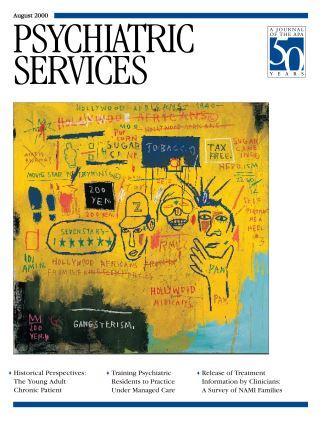•The Emergence of a New Population of Chronic Patients
In the late 1970s mental health professionals were beginning to recognize that a new generation of chronic patients was emerging, young adults who had spent relatively little time in psychiatric hospitals but presented challenging problems for staff in community programs. This month we continue our retrospective look at important developments in psychiatry over the past 50 years by reprinting a seminal article on young adult chronic patients by Bert Pepper, M.D., and associates from the July 1981 issue (see page 989). In a related commentary and analysis, Francine Cournos, M.D., and Stephanie Le Melle, M.D., note that the themes covered in the article came to dominate discourse about how to meet the needs of this new patient group (see page 996)…. In the Taking Issue column, Burton V. Reifler, M.D., M.P.H., points out that meeting the needs of a challenging new cohort of patients—those over age 65 with no previous history of serious and persistent mental illness—is the most important demographic imperative facing psychiatry today (see page 961).
•Residency Education and the Realities of Managed Care
The majority of residency education programs in psychiatry tend to neglect managed care, leaving psychiatrists without the knowledge and skills they need to work in a managed care environment. Michael A. Hoge, Ph.D., and his colleagues at Yale University School of Medicine outline new directions for residency education in which managed care receives more attention but is considered in the context of sweeping changes in such areas as cost control, evidence-based practice, and outcomes (see page 1001).
•Releasing Information
Clinical guidelines for treating severe mental illness recommend that providers share information with patients' families and involve them in treatment. However, many mental health agencies do not have clear procedures for releasing such information, and in most states providing even the most basic information without the client's consent is technically a breach of confidentiality. Tina Bogart Marshall, M.S.W., and Phyllis Solomon, Ph.D., surveyed members of the National Alliance for the Mentally Ill to gain insight into the types of information shared and the process by which it was released. They found that most families had been told about their ill relative's diagnosis and medication but not about the treatment plan. Requests for information were usually initiated by consumers or family members and required much personal effort, leading to dissatisfaction with contacts with providers (see page 1006).
•Studies of Homelessness
Three studies in this issue focus on various aspects of homelessness among people with serious mental illness. Eri Kuno, Ph.D., and his associates examined the rate of homelessness among a group of formerly hospitalized patients who were followed for four years after referral to an extended acute care facility. They found that 24 percent experienced a homeless episode despite extensive use of mental health resources (see page 1012)…. In a study of an intensive case management and rental assistance program for homeless veterans, Wesley J. Kasprow, Ph.D., M.P.H., and his coauthors found that the program was successful in keeping clients in stable housing, but it served only a small percentage of the eligible population (see page 1017)…. Gail Gamache, Ph.D., and associates studied factors predicting use of Veterans Affairs health care services by homeless veterans. They found that the highest service users were veterans who received VA benefits and who lived near a VA medical center (see page 1024).
•Effects of Divalproex on Length of Stay
Several studies have reported a shorter hospital stay when divalproex is used instead of lithium in treating bipolar disorder, an important finding because the shorter stay helps offset the higher cost of divalproex, a relatively new mood stabilizer. To confirm this finding in their treatment facility, Alican Dalkilic, M.D., and associates compared the length of stay of patients treated with divalproex and those treated with lithium. No significant differences were found. The authors call for more definitive studies to explore this issue (see page 1045).
Briefly Noted…
•The Best Practices column discusses implementation of best-practice guidelines for schizophrenia in a public institution (see page 972).
•The Alcohol & Drug Abuse column describes a model for self-help treatment for combined substance abuse and mental illness (see page 977).
•The Books section opens with a review of Why Americans Hate Welfare (see page 1056).

